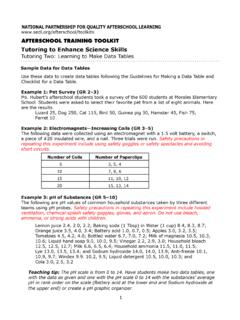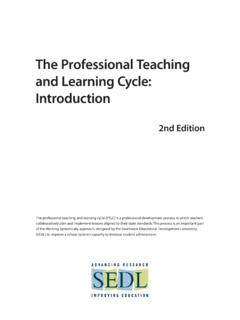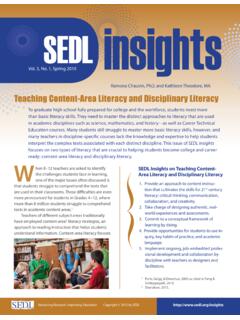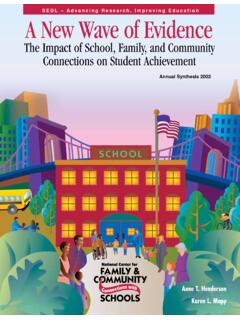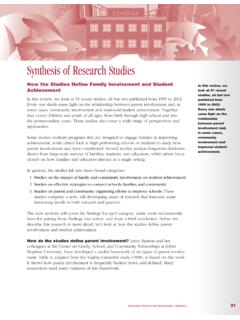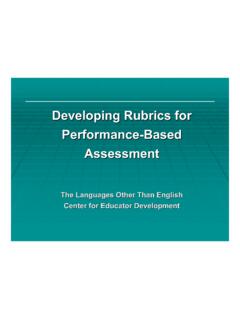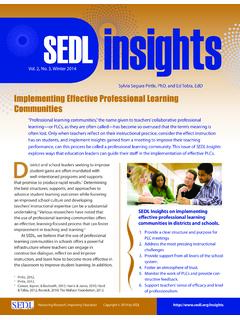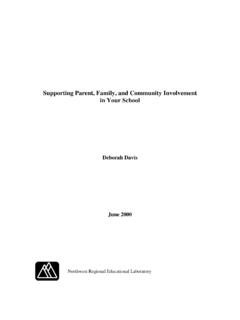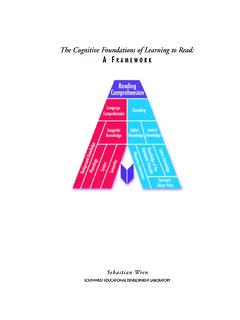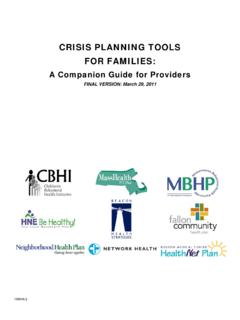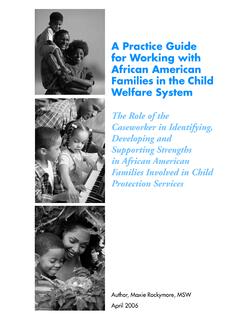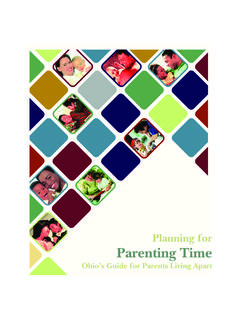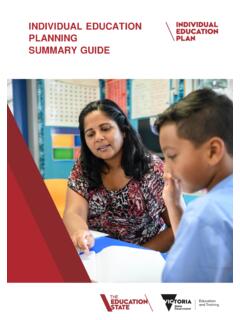Transcription of A Resource Guide for Planning and Operating Afterschool ...
1 A Resource Guide for Planning and Operating Afterschool Programs 3rd editionCompiled by Janet Hall BagbyContributorsEditorJanet Hall Bagby Production Laura ShanklandDeborah DonnellyCatherine Jordan CopyeditingDebbie RitenourDesignerShaila AbdullahCopyright 2008 SEDL 4700 Mueller , TX 78723 Voice: 800-476-6861 Fax: publication was produced in whole or in part with funds from the Office of Academic Improvement and Teacher Quality Programs, Department of Education under contract number ED-03-CO-0048. The content herein does not necessarily reflect the views of the Department of Education, any other agency of the government, or any other or names of specific software discussed or described in this document are registered trademarks or copyrighted as property of the companies that produce the note that the World Wide Web is volatile and constantly changing. The URLs provided in the following references were accurate as of the date of this publication, but we can make no guarantees of their CitationBagby, J.
2 H. (Ed.). (2008). A Resource Guide for Planning and Operating Afterschool programs (3rd ed.). Austin, TX: Resource Guide for Planning and Operating Afterschool ProgramsIntroduction .. 3 Afterschool Resources Programming .. 7 Organizational Development .. 47 Appendix A: Web Site List .. 97 Appendix B: Title Index .. 109 Appendix C: Author/Editor Index .. 117A Resource Guide for Planning and Operating Afterschool ProgramsSEDL | National Partnership for Quality Afterschool Learning3 IntroductionThis third edition of A Resource Guide for Planning and Operating Afterschool Programs provides a description of resources to support 21st Century Community Learning Center Afterschool programs. Many of the entries will also apply to before-school, summer, and community learning center programs. These resources meet three basic criteria: (1) they are timely, (2) they are readily available, and (3) they are relatively inexpensive. Approximately 75% of the entries are new or have been revised since the second edition was of the Guide In the earlier editions of this Guide , the resources were organized into six Afterschool categories identified by the National Center for Community Education Training Task Force for 21st Century Community Learning Centers.
3 In this new edition, the entries are organized alphabetically within one of two sections: (1) programming and (2) organizational development. A list of the topics and information covered in each of the sections section includes resources for developing an Afterschool program and providing instruction and enrichment activities. Information is provided on appropriate curriculum, youth development, behavior management, mentoring, developmental milestones, accreditation, parental and community involvement, and extending academic learning opportunities in the Afterschool DevelopmentThis section includes resources on Planning , organizing, managing, and sustaining Afterschool programs. Information is provided on leadership development, improving program outcomes, building relationships with community partners, effective communication, program evaluation, and data-collection following three appendixes at the back of the Guide provide additional information: Appendix A provides relevant online resources.
4 Appendix B lists the resources alphabetically by title (entries beginning with A and The are listed under the second word in the title). The Author Index lists alphabetically the resources by author or editor and page third edition of the A Resource Guide for Planning and Operating Afterschool Programs is as comprehensive as time and knowledge permitted. However, in this dynamic field of Afterschool programming, new resources are frequently generated. Your assistance in identifying additional resources for future editions of this Guide is appreciated. Please contact SEDL by e-mail at Resource Guide for Planning and Operating Afterschool and Using the GuideThe Guide is available in three formats: (1) print, (2) as a portable document (PDF), and (3) as an online FormatThe print format is available for purchase through SEDL at diagram below identifies the contents of a typical entry. PDFA Resource Guide for Planning and Operating Afterschool Programs is available online as a PDF at You are welcome to download and copy the Guide at no cost.
5 Please include the title page and front matter and list SEDL as the publisher if you distribute Database FormatA Resource Guide for Planning and Operating Afterschool Programs is also available online as a searchable database at Taylor-PowellThis evaluation Resource provides guidance on conducting sampling. It first addresses whether sampling is an appropriate evaluation tool for a particular program. Then it presents sampling for generalizability, or probability sampling, and talks about specific sampling strategies, including simple random sampling, systematic sampling, and stratified sampling. The Resource also explores sampling for other purposes, or non-probability sampling, including quota sampling and purposeful sampling. The appendixes list references, a table of random numbers, and recommended sample sizes. (12 pages)1998 Print $ Resource : Extension Publications University of Wisconsin 45 N. Charter St. Madison, WI 53715 Phone: 877-947-7827 AUthOr Or eDitOrtitleCOPyriGht DAteDesCriPtiOn OF COntentsCOstinternet ADDress PUblisher s COntACt inFOrmAtiOnresOUrCe FOrmAtA Resource Guide for Planning and Operating Afterschool ProgramsSEDL | National Partnership for Quality Afterschool Learning5 Features of the third editionApproximately 75% of the resources are new or revised.
6 This symbol identifies entries that are new to the third edition. This symbol in the margin identifies entries that have been revised since the second edition of A Resource Guide for Planning and Operating Afterschool Programs was section includes resources for developing an Afterschool program and providing instruction and enrichment activities. Information is provided on appropriate curriculum, youth development, behavior management, mentoring, developmental milestones, accreditation, parental and community involvement, and extending academic learning opportunities in the Afterschool program. A Resource Guide for Planning and Operating Afterschool ProgramsSEDL | National Partnership for Quality Afterschool Learning7 Programming Active Hours Afterschool : Childhood Obesity & the Role of Afterschool Programs as a Solution Afterschool AllianceObesity has been acknowledged as a growing concern in almost every part of the country. This document discusses how Afterschool programs are ideally positioned to help curb this problem among school-age children and what can be done.
7 (15 pages)No date Web Resource : Afterschool Alliance 1616 H St. NW, Ste. 820 Washington, DC 20006 Phone: 202-347-2030 Fax: 202-347-2092 Active Hours Afterschool : Local Wellness Policy Toolkit for Afterschool ProgramsAfterschool AllianceThe Child Nutrition and WIC Reauthorization Act of 2004 required every school district to develop a local wellness policy by the end of the 2006 2007 school year. This document discusses the minimum standards of such a policy and advocacy possibilities that Afterschool programs can help influence. (6 pages)2006 Web Resource : Afterschool Alliance 1616 H St. NW, Ste. 820 Washington, DC 20006 Phone: 202-347-2030 Fax: 202-347-2092 A Resource Guide for Planning and Operating Afterschool After School Guide : Nourish Their Bodies, Feed Their MindsFood Research and Action CenterThis document discusses why children need Afterschool programs and why nutrition is crucial to Afterschool success. It also provides insight into which federal child nutrition programs are available, what health and safety requirements apply, how to participate in such programs as the national school lunch program, and how to provide nutrition education.
8 An appendix listing state child nutrition agencies is included. (33 pages)No date Web Resource : Food Research and Action Center (FRAC) 1875 Connecticut Ave. NW, Ste. 540 Washington, DC 20009 Phone: 202-986-2200 Fax: 202-986-2525 Afterschool Matters Sara L. HillA successful Afterschool program or any educational endeavor balances academic learning with fun and enriching activities. Afterschool Matters addresses developmental stages, types of support for academically challenged children, and useful models developed by experts. Selected projects relate to various student interests and complement classroom learning while providing much-needed social interaction and artistic expression. (109 pages)2008 Print $ Press 2455 Teller Rd. Thousand Oaks, CA 91320 Phone: 800-233-9936 Fax: 800-417-2466 Resource Guide for Planning and Operating Afterschool ProgramsSEDL | National Partnership for Quality Afterschool Learning9 America s Children: Key National Indicators of Well-Being 2007 Federal Interagency Forum on Child and Family StatisticsThe Federal Interagency Forum on Child and Family Statistics seeks to improve consistency in data collection and reporting on children and their families.
9 This volume of America s Children presents a summary of 38 national indicators of important aspects of children s lives and the changes in these indicators from the previous year. The report has been restructured into seven sections: family and social environment, economic circumstances, health care, physical environment and safety, behavior, education, and health. Information such as the percentage of children that visit the dentist, the demographics of the child population, and the percentage of children with elevated blood-lead levels can be found in this report. (187 pages)2007 Print No CostWeb Resource : Resources and Services Administration Information Center Box 2910 Merrifield, VA 22116 Phone: 888-275-4772 Fax: 703-821-2098 E-mail: Best Practices: Guidelines for School-Age ProgramsMichael S. AshcraftMany children spend up to 35 hours a week in school-age care. The quality of these programs can have an enormous impact on their education and development. It is important for their experiences to be positive and beneficial.
10 Bringing together research on the brain, child development, and the theories of school-age child development, this book provides descriptions of specific best practices for school-age programs. Case studies are used to provide real-life examples of ideas and practices. This information will help you design an Afterschool program that promotes positive development of children or improve one already in existence. (140 pages)2007 Print $ Media Group 16588 Fieldcrest Ave. Farmington, MN 55024 Phone: 952-953-9166 Fax: 952-431-3461 E-mail: Resource Guide for Planning and Operating Afterschool Best Practices Workbook: Guidelines for School-Age ProgramsMichael S. AshcraftThis workbook is a companion to the book Best Practices: Guidelines for School-Age Programs. It is based on research and contains a set of checklists for best practices and practical guidelines to help facilitate the positive development of children. By allowing you to identify strengths, weaknesses, and methods for improvement, this Resource can be a great tool for self-assessment and growth.
